
American Airlines Flight 77 was a scheduled domestic transcontinental passenger flight from Dulles International Airport in Northern Virginia to Los Angeles International Airport in Los Angeles. The Boeing 757-223 aircraft serving the flight was hijacked by five al-Qaeda terrorists on the morning of September 11, 2001, as part of the September 11 attacks. The hijacked airliner was deliberately crashed into the Pentagon in Arlington County, Virginia, killing all 64 aboard and another 125 in the building.

Abdulaziz al-Omari was a Saudi terrorist who was one of five hijackers of American Airlines Flight 11 as part of the September 11 attacks in 2001.

Mark Kendall Bingham was an American public relations executive who founded his own company, the Bingham Group. During the September 11 attacks in 2001, he was a passenger on board United Airlines Flight 93. Bingham was among the passengers who, along with Todd Beamer, Tom Burnett and Jeremy Glick, formed the plan to retake the plane from the hijackers, and led the effort that resulted in the crash of the plane into a field near Shanksville, Pennsylvania, thwarting the hijackers' plan to crash the plane into a building in Washington, D.C., most likely either the U.S. Capitol Building or the White House.
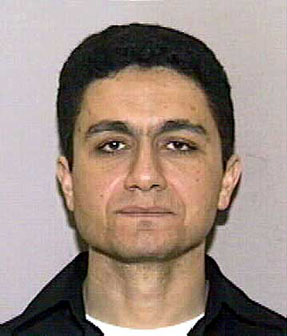
Mohamed Mohamed el-Amir Awad el-Sayed Atta was an Egyptian terrorist hijacker for al-Qaeda. Ideologically a pan-Islamist, he was the ringleader of the September 11 attacks and served as the hijacker-pilot of American Airlines Flight 11, which he crashed into the North Tower of the World Trade Center as part of the coordinated suicide attacks. Aged 33, he was the oldest of the 19 hijackers who took part in the mission.

The hijackers in the September 11 attacks were 19 men affiliated with Islamist jihadist organization al-Qaeda. They hailed from four countries; 15 of them were citizens of Saudi Arabia, two were from the United Arab Emirates, one was from Egypt, and one from Lebanon. To carry out the attacks, the hijackers were organized into four teams each led by a pilot-trained hijacker who would commandeer the flight with three or four "muscle hijackers" who were trained to help subdue the pilots, passengers, and crew. Each team was assigned to a different flight and given a unique target to crash their respective planes into. Mohamed Atta was the assigned ringleader over all 4 groups.

Communication problems and successes played an important role during the September 11 attacks in 2001 and their aftermath. Systems were variously destroyed or overwhelmed by loads greater than they were designed to carry, or failed to operate as intended or desired.
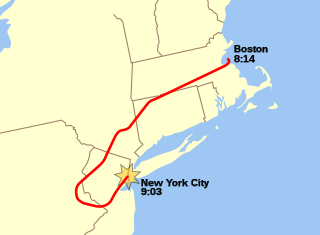
United Airlines Flight 175 was a domestic passenger flight from Logan International Airport in Boston to Los Angeles International Airport in California that was hijacked by five al-Qaeda terrorists on the morning of September 11, 2001, as part of the September 11 attacks. The aircraft involved, a Boeing 767-200 carrying 65 passengers and crew, was deliberately crashed into the South Tower of the World Trade Center in New York City, killing everyone aboard and causing the deaths of more than 600 people in the South Tower's upper levels in addition to an unknown number of civilians and emergency personnel on floors beneath the impact zone. Flight 175's hijacking not only led to it being the second-deadliest of the four suicide attacks carried out on the day in terms of plane and ground fatalities, but also secured its place as second-deadliest plane crash in aviation history, surpassed only by American Airlines Flight 11.

United Airlines Flight 93 was a domestic scheduled passenger flight that was hijacked by four al-Qaeda terrorists on the morning of September 11, 2001, as part of the September 11 attacks. The hijackers planned to crash the plane into a federal government building in the national capital of Washington, D.C. The mission became a partial failure when the passengers fought back, forcing the terrorists to crash the plane in Somerset County, Pennsylvania, preventing them from reaching al-Qaeda's intended target, but killing everyone aboard the flight. The airliner involved, a Boeing 757-222 with 44 passengers and crew, was flying United Airlines' daily scheduled morning flight from Newark International Airport in New Jersey to San Francisco International Airport in California, making it the only plane hijacked that day not to be a Los Angeles–bound flight.

Ziad Samir al-Jarrah was a Lebanese terrorist hijacker. He was one of the four hijackers of United Airlines Flight 93, which was crashed into a field in a rural area near Shanksville, Pennsylvania, following a passenger revolt, as part of the 11 September attacks.

Marwan Yousef Mohamed Rashid Lekrab al-Shehhi was an Emirati terrorist hijacker from al-Qaeda who served as the hijacker-pilot of United Airlines Flight 175, crashing the Boeing 767 into the South Tower of the World Trade Center as part of the 11 September attacks in 2001. He was one of five hijackers aboard the aircraft and one of two Emiratis to take part in the attacks, the other being Fayez Banihammad, who helped him hijack the same plane.
The September 11 attacks of 2001, in addition to being a unique act of terrorism, constituted a media event on a scale not seen since the advent of civilian global satellite links. Instant worldwide reaction and debate were made possible by round-the-clock television news organizations and by the internet. As a result, most of the events listed below were known by a large portion of the world's population as they occurred.

Fayez Rashid Ahmed Hassan al-Qadi Banihammad, commonly known as Fayez Banihammad, was an Emirati terrorist who was one of five hijackers of United Airlines Flight 175, which crashed into the South Tower of the World Trade Center as part of the September 11 attacks in 2001.

There are various conspiracy theories that attribute the preparation and execution of the September 11 attacks against the United States to parties other than, or in addition to, al-Qaeda. These include the theory that high-level government officials had advance knowledge of the attacks. Government investigations and independent reviews have rejected these theories. Proponents of these theories assert that there are inconsistencies in the commonly accepted version, or that there exists evidence that was ignored, concealed, or overlooked.

Jules Clément Naudet and brother Thomas Gédéon Naudet are French-American filmmakers. The brothers, residents of the United States since 1989 and citizens since 1999, were in New York City at the time of the September 11 attacks to film a documentary on members of the Engine 7, Ladder 1 firehouse in Lower Manhattan.
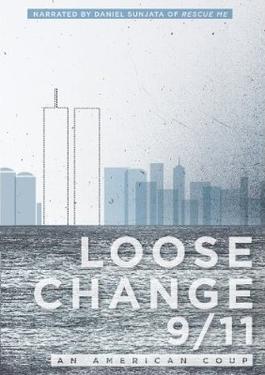
Loose Change is a series of films released between 2005 and 2009 that argue in favor of certain conspiracy theories relating to the September 11 attacks. The films were written and directed by Dylan Avery and produced by Korey Rowe, Jason Bermas, and Matthew Brown.
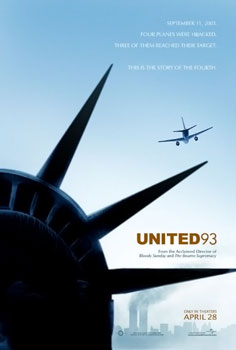
United 93 is a 2006 docudrama thriller film written and directed by Paul Greengrass. The film largely chronicles the events aboard United Airlines Flight 93, one of the four hijacked flights during the September 11 attacks and the only one not to hit its intended target due to the intervention of passengers and crew; it also covers the experiences of government officials and air traffic controllers watching the other events of the attacks unfold.

The September 11 attacks, commonly known as 9/11, were four coordinated Islamist suicide terrorist attacks carried out by al-Qaeda against the United States on September 11, 2001. That morning, 19 terrorists hijacked four commercial airliners scheduled to travel from the East Coast to California. The hijackers crashed the first two planes into the Twin Towers of the World Trade Center in New York City, two of the world's five tallest buildings at the time, and aimed the next two flights toward targets in or near Washington, D.C., in an attack on the nation's capital. The third team succeeded in striking the Pentagon, the headquarters of the U.S. Department of Defense in Arlington County, Virginia, while the fourth plane crashed in rural Pennsylvania during a passenger revolt. The September 11 attacks killed 2,977 people, making them the deadliest terrorist attack in history. In response to the attacks, the United States instigated the multi-decade, global war on terror, with the aim to eliminate hostile groups they deemed as terrorist organizations, as well as the foreign governments they purported to support them. Conflicts were fought in Afghanistan, Iraq, Pakistan, and several other countries, under this pretense.

Todd Morgan Beamer was an American passenger aboard United Airlines Flight 93, which was hijacked and crashed as part of the September 11 attacks in 2001. He was one of the passengers who attempted to regain control of the aircraft from the hijackers. During the struggle, the Boeing 757 lost control and crashed into a field in Stonycreek Township near Shanksville, Pennsylvania, killing everyone on board, but saving the hijackers' intended target and additional victims.
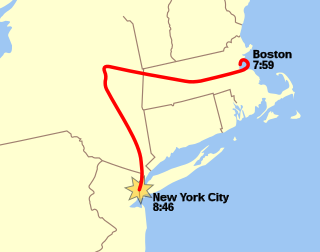
American Airlines Flight 11 was a domestic passenger flight that was hijacked by five al-Qaeda terrorists on the morning of September 11, 2001, as part of the September 11 attacks. The hijacked airliner was deliberately crashed into the North Tower of the World Trade Center complex in New York City, killing everyone aboard the flight and resulting in the deaths of more than one thousand people in the top 18 stories of the skyscraper in addition to causing the demise of numerous others below the trapped floors, making it not only the deadliest of the four suicide attacks executed that morning in terms of both plane and ground fatalities, but also the single deadliest act of terrorism in human history and the deadliest plane crash of all time. The aircraft involved, a Boeing 767-223ER with 92 passengers and crew, was flying American Airlines' daily scheduled morning transcontinental service from Boston Logan International Airport in Massachusetts to Los Angeles International Airport in California.

The September 11 attacks of 2001 were the deadliest terrorist attacks in human history, causing the deaths of 2,996 people, including 2,977 victims and 19 hijackers who committed murder–suicide. Thousands more were injured, and long-term health effects have arisen as a consequence of the attacks. New York City took the brunt of the death toll when the Twin Towers of the World Trade Center complex in Lower Manhattan were attacked, with an estimated 1,600 victims from the North Tower and around a thousand from the South Tower. Two hundred miles southwest in Arlington County, Virginia, another 125 were killed in the Pentagon. The remaining 265 fatalities included the ninety-two passengers and crew of American Airlines Flight 11, the sixty-five aboard United Airlines Flight 175, the sixty-four on American Airlines Flight 77 and the forty-four who boarded United Airlines Flight 93. The attack on the World Trade Center's North Tower alone made the September 11 attacks the deadliest act of terrorism in human history.























